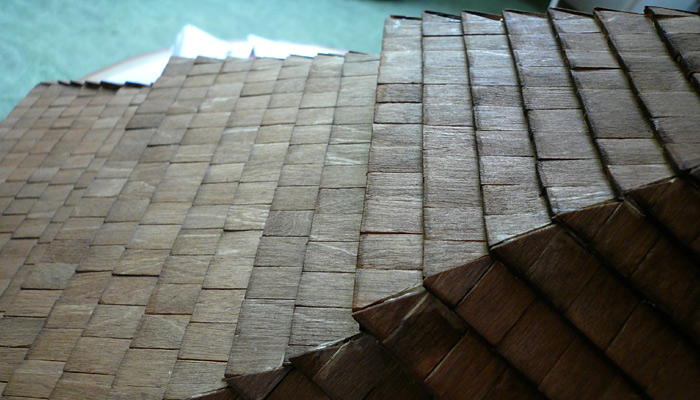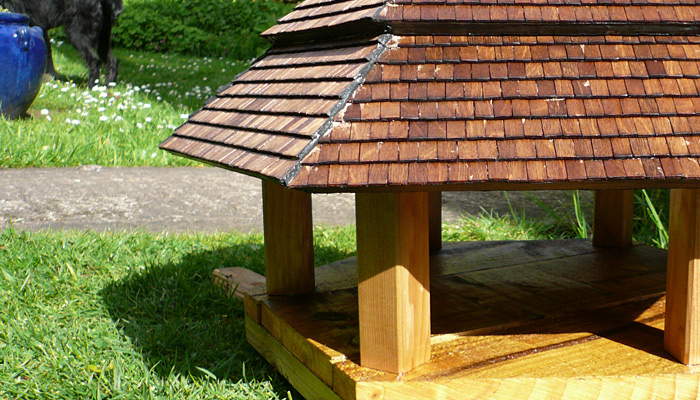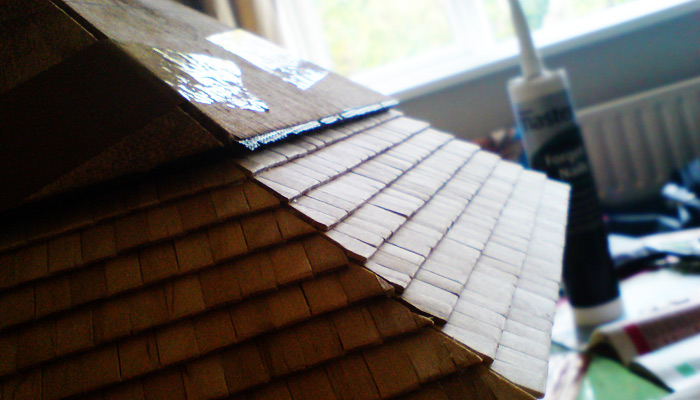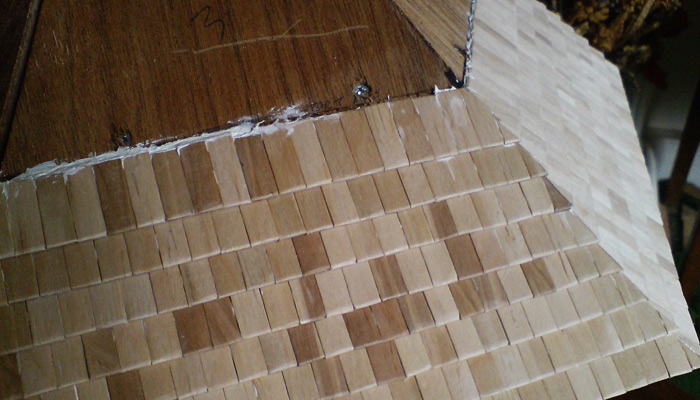Posts Tagged ‘Hexagonal Bird Table’
Project Hex: Building an Hexagonal Bird Table (Part 4)

Having got the roof fully tiled, focus shifted to the finish of the roof. As previously mentioned, I delved online to research staining and weatherproof wood.
I could have simply slapped on some standard woodstain, but I wanted a more natural finish, something that lets the grain of the wood be the star.
A technique that caught my interest was one which naturally ages wood. Wood greys with age, just look at an old garden fence, or the oak timbers of a Tudor house. Some woods darken more than other, like English oak. This is due to it having higher levers of tannin than other woods. Over time sunlight and the environment darkens the wood.
The technique I found is pretty simple. You pop some wire wool into a jar of malt vinegar and leave it for a few days to a week. Brush this onto the wood and a chemical reaction occurs. The wood darkens with a beautiful grey-silverish tint, which deepens over a few days. If the wood you want to ‘age’ has low levels of tannin in it, then you need to add some… simply use stewed tea bags. Tea has high amounts of tannin, yes the wood gets a tea colouring to it, but the main aim is to get the invisible tannins into the wood. This is what I did to the roof of the bird table. Maybe red wine would have the same effect?? I didn’t try it.
The beauty of this technique is that it isn’t a stain, it is a chemical reaction. In essence, it is aging of the wood in fast forward. The effect is wonderful, the vinegar/steel mix collects and pools in grains, grooves, nick & dips. Here it darkens more than other areas, giving a very natural effect. The ‘aging’ vinegar concoction is pretty potent too. Apply it ‘neat’ and wood can go jet black in seconds. Whilst testing on some off-cuts, I found 1 to 20 dilution gave a slightly tinted effect. This is the technique I used, applying tint, allowing to dry, then repeating until I got the look I wanted.
 The first treatment of the vinegar/steel wool mixture, you can see the wood darken slightly.
The first treatment of the vinegar/steel wool mixture, you can see the wood darken slightly.
 After a few treatments, the wood dries to a greyish-brown. You can see that the wood looks ‘aged’.
After a few treatments, the wood dries to a greyish-brown. You can see that the wood looks ‘aged’.
 Another shot showing the ‘aging’ process.
Another shot showing the ‘aging’ process.
 The first treatment of tung oil goes on one aspect (the left hand side of this picture)
The first treatment of tung oil goes on one aspect (the left hand side of this picture)
For weatherproofing, my research highlighted tung oil as the best option. The Chinese have been using the stuff for 1000’s of years to waterproof their boats. The reason it isn’t commonly used today is that it is a laborious task to achieve a good level of waterproofing. It isn’t difficult, it simply takes time. You have to apply it thinned down 50/50 with white spirit, so it soaks deep into the wood. Wait for it to dry, then repeat, gradually reducing the amount of thinner used. To do it properly, layer after layer after layer needs to be applied, eventually using it neat for several top coats.
The results are worth it, plus it has other benefits. It is not harmful to wildlife, as tung oil comes from a nut. Maintenance of the wood is easy, no sanding or scraping every year or so. Instead, every six to twelve months or so, simply brush some more tung oil onto the wood. It should be completely water tight, as the oil fills the gaps and fissures in the wood grain, then cures over time. I’m looking forward to seeing the rain bead off it in the garden, with the same satisfaction you get from a downpour on freshly waxed car bodywork ~ maybe that’s a bloke thing?
 The ridge joins were filled with black exterior sealant prior to applying the tung oil.
The ridge joins were filled with black exterior sealant prior to applying the tung oil.
 The entire roof after a few applications of tung oil.
The entire roof after a few applications of tung oil.
 Outside, drying in the sun.
Outside, drying in the sun.
 When the sunlight catches the wood, the natural translucent grain is brought out, giving a golden sheen.
When the sunlight catches the wood, the natural translucent grain is brought out, giving a golden sheen.
 The untreated (‘un-aged’), but oiled base and pillars have a lovely golden colour.
The untreated (‘un-aged’), but oiled base and pillars have a lovely golden colour.
 Reverse birds eye view… looking up into the eves.
Reverse birds eye view… looking up into the eves.
The process has slowed down somewhat. As each application of tung oil needs to be left to thoroughly dry, it takes longer and longer between ‘coats’. This is due to the deep wood grains filling up with oil, so in soaks in less. It’s taking over two weeks for each application to dry now. Any ‘excess’ that is left on the wood surface will be ‘sanded’ down with 1000 grade wire wool – it’s more of a polishing than a sanding, plus it removes dust and contaminants that have stuck themselves to the oil. This result should be a satin gloss finish. I’ve periodically wiped away any excess on the roof tiles as I want a matt finish, plus ‘polishing’ the tiles would be a nightmare.
I am now at the stage of applying the third pure undiluted tung oil to all areas. I reckon that it will be waterproof in one more application, I will test with some water.
My focus is now on designing the stand and base. As the table is moderately heavy, the idea of having an integral hexagonal planter as the base seems the best way to go. When filled with soil and plants, there will be zero risk of the bird table blowing over in the wind.
Project Hex: Building an Hexagonal Bird Table (Part 3)

As you can see, the three tiers of tiled roof has been completed. I’m pretty pleased with the outcome, the slightly varying shades of the chopped up lollipop sticks give the roof a beautiful effect.
Below you can see the various build stages of getting this far. During the tiling stage, I gave some thought to what type of colouring, staining and protection I should apply to the roof. Part of me wanted to let the natural shades of the roof stay as they are, but after a little digging around online I decided that a deeper colour would be preferable.
I spent some time online researching ways of achieving a weathered darker colour, without losing the natural beauty of the wood. I found some interesting articles on how to naturally weather the wood.
 Second tier gets underway
Second tier gets underway
 Another section of the second tier complete
Another section of the second tier complete
 Second tier complete and the base of the final third tier is glued & screwed in place
Second tier complete and the base of the final third tier is glued & screwed in place
 Roof cap section takes shape
Roof cap section takes shape
I was simply going to fit a wooden finial to the top of the main roof, like a ball shape that are common on staircase banisters. Having failed to find an hexagonal finial for sale (that wasn’t extortionately priced), I decided to construct a ‘bell tower-like’ structure. I’m sure there is a technical name for this part of a building, dovecote maybe?
I decided against using wooden tiles on the ‘dovecote’ roof, as it would be near on impossible to get a truely waterproof cap. I entertained using copper sheet, but worried that the corrosive run-off of water would stain the wooden tiles on the main roof below. I tried creating a one-piece aluminium roof out of an inside out beer can, but the metal was so thin it simply split when folded. Eventually I settled on raiding the back of the garage and using a cut-off of self adhesive roofing felt, the sort with stone chips pressed into it.
 Testing fitment of ‘dovecote’
Testing fitment of ‘dovecote’
 Shot from above, showing the now felted ‘dovecote’
Shot from above, showing the now felted ‘dovecote’
Next stage is sealing the ridge area, eves and applying a weathered effect & waterproofing.
Project Hex: Building an Hexagonal Bird Table (Part 2)

Having decided that the ’tiled’ route was definitely the best way forward, I forged on with tiling all six sides of the first tier. The cutting and sanding of each tile was getting laborious, so I cut and filed a dozen or so at a time, then glue them to the roof base. Mainly doing a row at a time.
Cutting the trianglar tiles for the ridge areas was the most difficult part. I had to cut against the wood grain in a specific direction, otherwise the tiny wood tiles would break up. I have to say, the gluing of the tiles was very therapeutic, and definitely the best part. The benefit of the slow drying glue is that it allowed for adjustment. The aligning of the tiles was most important, over the length of a section it was easy to be 5mm out vertically, so a constant check on levels and spacing was needed.
 Starting where I left off
Starting where I left off
 The entire first tier complete
The entire first tier complete
 View from directly above
View from directly above
 I couldn’t get the tiles perfect along the ridges, but close enough
I couldn’t get the tiles perfect along the ridges, but close enough
 With the first tier complete and dried, it was time for the second tier base to go on
With the first tier complete and dried, it was time for the second tier base to go on
 The six triangles of outdoor grade plywood go on, held in place with tape, to create the second tier.
The six triangles of outdoor grade plywood go on, held in place with tape, to create the second tier.
 ‘Birds eye view’… some shots of up inside the roof section
‘Birds eye view’… some shots of up inside the roof section
 The inside of the top of the roof… the staining is just oil that hasn’t dried.
The inside of the top of the roof… the staining is just oil that hasn’t dried.
Part 3 will follow soon…
Project Hex: Building an Hexagonal Bird Table (Part 1)

I’ve been meaning to document the build of ‘Project Hex’ for some time, since I began in the Autumn of 2008.
Yes, the above photo isn’t that inspiring, but it represents the start of this slightly oddball way of spending some of my weekends.
I guess it all started when I built a regular rectangular, pitched roof bird table a while back. I was quite pleased with the way it came out and it got me thinking.
I wanted to have a go at something more involved, more challenging. This isn’t so much as a hobby, as something to do when I was bored, or the weather was bad. Also, I had recently lost my faithful dog of 13 plus years and needed to keep my mind occupied, so I guess this is what I did.
Unfortunately, I don’t have any photos from the early stages of building the bare-bones structure of the table, so all the pics I have are from the beginning of the tiling stage. As you can see, it shows the start of tiling the roof with small wooden tiles. I originally planned to cover the bird table with some roof felt that was kicking around the garage. Although the felt looked OK, it didn’t really have a wow factor…. hence the wooden tiles idea.
I decided to rip the felt off and have a go at creating a tiled roof. I headed down to the local retail park and into a large ‘hobby’ store. I left clutching a jumbo sized bag of standard lollipop sticks. This is not as mad as it sounds, the white birch wood used for lollipop sticks is high quality as it is primarily used in food. So, no splinters, no weak wood with consistent quality and thickness.
I had cut each tile with some wire snips. Resulting in 4 tiles from each lollipop stick. Each tile was then filed smooth at one end and pencil marked accordingly. A flexible outdoor waterproof glue was used to mount the tiles on the triangular sections of outdoor grade plywood that make the base structure of the roof.
 The beginning of the tiling process
The beginning of the tiling process
 One side of the first tier complete
One side of the first tier complete

With the now defunct roof felt removed, side two of the first tier gets underway.
Any gaps bordering the roof base where filled with black outdoor silicon sealant. The reason I have only tiled 1/3 of the way up the roof is that I intend to have a three tiered roof.
I have many more photographs to sort out, so further updates will be forthcoming.



